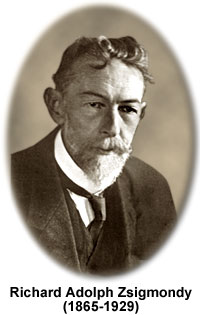Richard Adolph Zsigmondy
(1865-1929)

Richard Adolph Zsigmondy was an Austrian chemist and professor who invented the ultramicroscope and used the device to make numerous discoveries regarding the nature of colloids. Born on April 1, 1865, Zsigmondy was one of four sons of a well-respected dentist and inventor of surgical instruments who instilled an interest in the natural sciences in his children. In his youth, Zsigmondy was particularly interested in physics and chemistry, but was also fond of outdoor activities such as mountaineering and swimming. Although his father died when he was a teenager, his mother continued to encourage his pursuit of knowledge.
After graduating from high school in 1883, Zsigmondy began studies at the Vienna Polytechnic University. There he majored in chemistry and received his degree in 1887. He went on to pursue his doctorate in organic chemistry, continuing his education at the University of Munich. After he completed his degree, Zsigmondy accepted a position as research assistant for the physicist Professor Kundt at the University of Berlin. Kundt, who was a specialist on the colorization of glass by inorganic matter, helped promote Zsigmondy's interest in the area.
Although he accepted a teaching position at the Polytechnic University in Graz, Austria, in 1893, Zsigmondy's interest in colored glass did not wane. When he joined the Schott Glass Company in Jena, Germany in 1897 he continued his efforts in the area and developed what came to be known as Jena milk glass, an extremely popular commodity. This same work led to his increased involvement with colloids, which are often the basis for the colorization of glassy materials. Frustrated with the inability of ordinary light microscopes to aid in his research due to the extremely small size of colloidal particles, Zsigmondy decided to find a way to correct the problem.
In 1900, Zsigmondy left the working world and devoted himself for the next seven years to independent scholarly research, financed by a family fortune. It was during this time that he developed his ultramicroscope, working in conjunction with physicist Heinrich F. W. Siedentopf of the Zeiss optical works. The instrument, completed in 1903, illuminated colloidal particles with an intense beam of light oriented in a position perpendicular to the microscope's optical axis. As particles scattered the incident light, their movements could be seen as flashes against a dark background. The invention was a tremendous breakthrough in colloidal chemistry, enabling Zsigmondy and others to make observations and conclusions that were never before feasible.
Zsigmondy returned to academia in 1907, accepting a professorship and position as director of the Institute of Inorganic Chemistry at the University of Göttingen, but continued his work in colloidal chemistry. His efforts to improve upon the design of the ultramicroscope resulted in the invention of the immersion ultramicroscope in 1913. Then, in 1925, he received the crowning glory of his career when he was awarded the Nobel Prize in Chemistry for his inventions and colloid research. Zsigmondy retired from his academic posts in February 1929 and died later that same year from arteriosclerosis.
